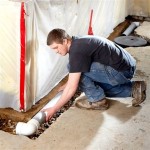How to Install a Radon Mitigation System in Your Basement
Radon is a naturally occurring radioactive gas that can cause lung cancer. It is found in the air and soil, and it can seep into your home through cracks in the foundation or other openings. If you are concerned about radon levels in your home, you can have a radon test performed. If the test results show that your radon levels are high, you should consider installing a radon mitigation system.
Radon mitigation systems work by drawing radon gas out of the air and venting it outside. There are two main types of radon mitigation systems: active systems and passive systems. Active systems use a fan to draw radon gas out of the air, while passive systems rely on natural air currents to move the gas outside.
The type of radon mitigation system that is best for your home will depend on a number of factors, including the size of your home, the radon levels in your home, and the climate in your area. A qualified radon mitigation contractor can help you choose the right system for your home.
Here are the steps involved in installing a radon mitigation system in your basement:
- Choose a qualified radon mitigation contractor. It is important to choose a contractor who is experienced in installing radon mitigation systems. The contractor should be able to provide you with a detailed proposal that outlines the cost of the system and the installation process.
- Get a permit. In most areas, you will need to obtain a permit before you can install a radon mitigation system. The permit process will vary depending on your local building codes.
- Install the radon mitigation system. The installation process will vary depending on the type of system you choose. However, in general, the contractor will need to drill a hole in the basement floor, install a PVC pipe, and connect the pipe to a fan or other device that will draw radon gas out of the air.
- Test the system. Once the system is installed, the contractor will need to test the system to ensure that it is working properly. The test will involve measuring the radon levels in the basement before and after the system is turned on.
- Maintain the system. Radon mitigation systems require regular maintenance. The contractor will provide you with instructions on how to maintain the system. In general, you will need to check the system monthly to ensure that it is working properly and to replace the fan or other device as needed.
Installing a radon mitigation system is an important way to protect your family from the health risks associated with radon gas. If you are concerned about radon levels in your home, you should contact a qualified radon mitigation contractor to have a radon test performed. If the test results show that your radon levels are high, you should consider installing a radon mitigation system.

Radon Your Uninvited Unseen Unwanted House Guest The Navage Patch

Radon Mitigation System 04 08 2024

Pre Piping For Radon Jlc Online

Sump Pump Radon Mitigation Drain Tile System Custom Installation Lifetime Solutions Delafield Wisconsin

Radon Mitigation Installation Massachusetts Home Inspections

Reducing Radon In Your Home National Program Services

Radon Mitigation System 05 03 2024

How To Retrofit A Radon Mitigation System

Radon Mitigation Systems Fine Homebuilding

Radon Mitigation System Benefits Of Installing In Attic
See Also








